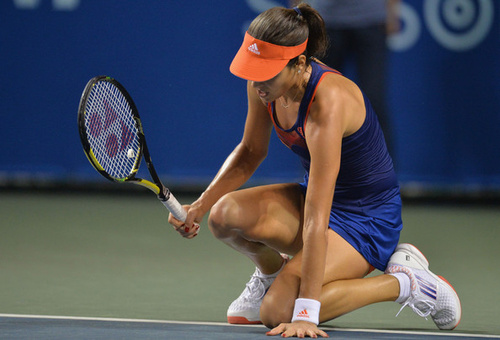Don't miss any stories → Follow Tennis View
FollowAna Ivanovic: One Step Forward, One Step Back
At just 25 years of age, Ana Ivanovic has endured a career with as many ups and downs as Novak Djokovic’s ball bounces: from reaching the No. 1 ranking and winning the Roland Garros title to falling outside the top 60 while struggling to advance deep into any draws. The media has often questioned whether Ivanovic still belongs in the top 20, where she has stayed consistently in recent months. But her latest form has showed that not all is lost with the glamorous, enigmatic world No. 16, although plenty of doubt still clouds her future.
On paper, Ivanovic has the weapons necessary for success at the highest level. At her best, she strikes a booming serve and a ferocious forehand flatter than anyone in the top 20. Those weapons have remained inconsistent for most of her post-2008 career, however. The only consistent trait of the former No. 1 is her lack of confidence at key moments and against elite opponents, which has prevented her from fulfilling her potential.

One might have expected Ivanovic to become one of the toughest competitors in the WTA, considering a childhood in war-torn, internationally ostracized Serbia. To the contrary, she has never quite overcome her mental fragility and her struggle to find comfort within herself and as a competitor at the professional level.
This lack of confidence may have been spawned by not being able to find the right mentor. Stuck in what seems like a vicious circle, Ivanovic’s inability to find a coach that suits her style of play has marred her journey and invariably unglued her during the pressure moments of her career. Shifting from Sven Groeneveld to Craig Kardon to Heinz Gunthardt to Antonio Van Grichen to Nigel Sears, she has cycled through a series of coaches and trainers since her 2008 breakthrough, never able to find the right fit for long. In the aftermath of the split with Sears, a Brit who had coached her for two years, some of Ivanovic’s supporters resigned themselves to a career filled with unfulfilled potential.
But the second half of 2013 has offered a glimmer of hope that Ivanovic still may evolve into a more solid and mature player able to capitalize on her talents. Twice she took sets from world No. 2 Victoria Azarenka in tight encounters on the American hard courts, including a fourth-round battle at the US Open. Following her familiar trends against elite players in 2009-13, however, she could not win the key points late in the match to close out the upset.
At this week’s Toray Pan Pacific Open in Tokyo, Ivanovic again gave her fans fleeting belief that she can turn things around in 2014. She won her first two matches for the loss of five total games. And then her inconsistency resurfaced, most notably on serve, as she fell in two routine sets to Angelique Kerber. That setback felt especially disappointing after her two victories over Kerber earlier this year.
Still in the middle period of her career, the Serb potentially has five or six years left in the top 20. The WTA has grown deeper with talented and resilient competitors since 2008, but Ivanovic knows what she can achieve when she puts all of the pieces together. Sooner or later, though, she must find someone to help her do it.










